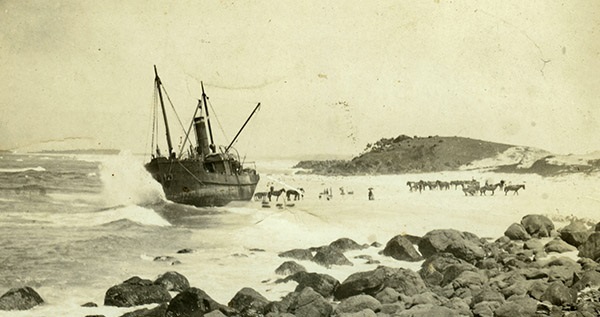The ship that named a beach
 The Duranbah aground on the beach,1919. TRM Collection M15-33.
The Duranbah aground on the beach,1919. TRM Collection M15-33.The North Coast Steam Navigation Company’s Duranbah was named after the farmland area near Cudgen. It carried coal for the Colonial Sugar Refinery, owners of the Condong Sugar Mill, and Norco, a company operating butter factories in northern NSW. The Duranbah also carried general cargo between north coast ports and Sydney.
On the morning of 6 November, 1919, under tow by the tug the Terranora, the Duranbah touched a reef. Rough seas, combined with fierce winds, ran her aground on the beach.
Stuck on the shore, the whole crew set to work to lighten the ship by throwing the deck cargo overboard. The effort was too late, she embedded further in the sand. Almost a week later salvage operations begun and over a few days most of the cargo was unloaded onto the Cudgen, a river punt, for transport up the river to Murwillumbah. Three weeks after grounding, the Duranbah was considerably lightened and conditions were ideal. On the high tide at mid-day on 30 November, the Duranbah successfully extricated herself from the sand.
The beach became known as Duranbah Beach, which was confusing as the farming area of Duranbah was around 20km south. The beach became one of the most popular beaches on the coast for board riders. Because of confusion with the name it was changed to Flagstaff Beach in the 1980s. This new name was never popular, and eventually it was officially changed back to Duranbah Beach.
Brass Doorplate from the Duranbah
This brass doorplate, from the Captain’s Cabin on the Duranbah, was donated to the Museum by local resident William Powell in 2000. It was mounted on timber for display purposes. The brass doorplate would have been directly fixed to the Captains’ door.
Brass doorplate. Donated by William Powell. TRM Collection TH2000.12